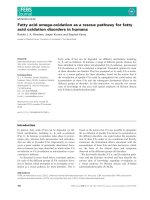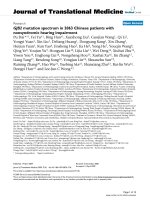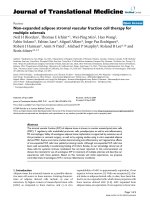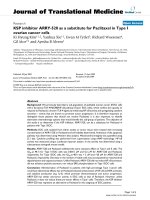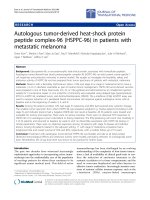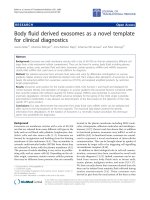báo cáo hóa học:" Body fluid derived exosomes as a novel template for clinical diagnostics" ppt
Bạn đang xem bản rút gọn của tài liệu. Xem và tải ngay bản đầy đủ của tài liệu tại đây (602.83 KB, 9 trang )
RESEARC H Open Access
Body fluid derived exosomes as a novel template
for clinical diagnostics
Sascha Keller
2†
, Johannes Ridinger
2†
, Anne-Kathleen Rupp
2
, Johannes WG Janssen
1
and Peter Altevogt
2*
Abstract
Background: Exosomes are small membrane vesicles with a size of 40-100 nm that are released by different cell
types from a late endosomal cellular compartment. They can be found in various body fluids including plasma,
malignant ascites, urine, amniotic fluid and saliva. Exosomes contain proteins, miRNAs and mRNAs (exosome
shuttle RNA, esRNA) that could serve as novel platform for diagnosis.
Method: We isolated exosomes from amniotic fluid, saliva and urine by differential centrifugation on sucrose
gradients. Marker proteins were identified by Western blot and FACS analysis after adsorption of exosomes to latex
beads. We extracted esRNA from exosomes, carried out RT-PCR, and analyzed amplified products by restriction
length polymorphism.
Results: Exosomes were positive for the marker proteins CD24, CD9, Annexin-1 and Hsp70 and displayed the
correct buoyant density and orientation of antigens. In sucrose gradients the exosomal fractions containe d esRNA
that could be isolated with sufficient quantity for further analysis. EsRNAs were protected in exosomes from
enzymatic degradation. Amniotic fluid esRNA served as template for the typing of the CD24 single nu cleotide
polymorphism (rs52812045). It also allowed sex determination of the fetus based on the detection of the male
specific ZFY gene product.
Conclusions: Our data demonstrate that exosomes from body fluids carry esRNAs which can be analyzed and
offers access to the transcriptome of the host organism. The exosomal lipid bilayer protects the genetic
information from degradation. As the isolation of exosomes is a minimally invasive procedure, this technique
opens new possibilities for diagnostics.
Background
Exosomes are membrane vesicles with a size of 40-100
nm that are released from many different cell types in the
body such as red blood cells, plate lets, lymphocyt es, den-
dritric cells and also tumor cells [1-3]. Exosomes are
formed by invagination and budding from the limiting
membrane of late endosomes [4,5]. T hey accumulate in
cytosolic multivesicular bodies (MVBs) from where they
are released by fusion with the plasma membrane [4,5].
The process of vesic le shedding is ve ry active in prolifer-
ating cells, such as cancer cells [6]. Depending on the cel-
lular origin, exosomes contain various cellular proteins
that may be different from proteins that are normally
located in the plasma membrane including MHC mole-
cules, tetraspanins, adhesion molecules and metallopro-
teinases [1,2,7]. Recent work has shown that, in addition
to functional proteins, exosomes carry mRNA as well as
miRNAs [8,9] . In funct ional terms, exosomes are consid-
ered to represent a novel mechanism of intercellular
communication. This can be brought about by uptake of
exosomes by target cells or by triggering cell signalling
via membrane receptors [8,10].
In addition to their biological role in cell-cell commu-
nication, exosomes have been considered as novel tools
for early diagnosis [11,12]. Indeed, exosomes can be iso-
lated from various body fluids such as breast milk,
serum, plasma, malignant ascites, and urine [9,13-17].
We have recently shown that exosomes derived from the
fetus can be isolated from amniotic fluid collected during
routine amnioscentesis [18]. These exosomes were
derived in pa rt from the renal system of the fetus as th ey
* Correspondence:
† Contributed equally
2
Tumor Immunology Programme, D015, German Cancer Research Center, D-
69120 Heidelberg, Germany
Full list of author information is available at the end of the article
Keller et al. Journal of Translational Medicine 2011, 9:86
/>© 2011 Keller et al; licensee BioMed Centr al Ltd. This is an Open Access article distributed under the terms of the Creative Commons
Attribution License ( which permits unrestricted use, distribution, and reproduction in
any medium, prov ided the original work is properly cited.
carried kidney markers and could be distinguished by
buoyant density from maternal exosomes [18]. However,
the c ontent of the shuttled RNA (exosomal shuttle
RNA = esRNA) of these exosomes and their usefulness
for diagnosis have not been investigated.
In the present publication w e investigated for the first
time in a systematic fashion whether esRNA can b e used
for diagnostic purposes. First we demonstrate that esRNA
copurifies with exosomal protein markers on sucrose gra-
dientsandthatesRNAcanbeisolatedfromexosomes
from amniotic fluid, urine and saliva. Using the CD24
SNP (rs52812045, at position 170 from the CD24 transla-
tion start site) as a model system, we show that individuals
can be successfully typed using esRNA as template. We
also show that esRNA from amniotic fluid can be used to
determine the sex of the fetus. Although the selected
experimental examples are presently performed by stan-
dard methods, the use o f es RNA r epresents the proof of
principle of a new method using exosomes.
Methods
Human samples
Analysis of biological samples was carried out under the
approval of the ethics commission of the University of
Heidelberg. Amniotic fluid was collected for routine
amniocentesis and analyzed after removal of cells. Urine
and saliva sample s were collected from healthy donors
(male and female). For the isolation of microvesicles body
fluids were spun for 20 min at 300 × g to remove cells and
20 min at 10, 000 × g to remove cellular debris. The vesi-
cles were pelleted using a Be ckmann ultracentrifuge at
100,000 × g. The vesicle pellet was tak en up in SDS sam-
ple buffer for direct analysis or further processed by
sucrose density centrifugation. Mean values of exos omal
protein isolated from amnio tic flu id were: 36 μg/ml
(range: 12 - 78 μg/ml, n = 93) and urine 6 μg /ml (range:
1.6 - 13 μg/ml, n = 14).
Chemicals and antibodies
The mAb to human CD24 (SWA11) was described [19].
The mAbs to HSP70, Annexin-1, CD9, and ADAM10
were from BD-Transduction (Heidelberg, Germany).
Sucrose density gradient fractionation
Isolated microvesicles were loaded onto the top of a step
gradient comprising layers o f 2 M, 1.3 M, 1.16 M, 0.8
M, 0.5 M and 0.25 M sucrose as described [14]. The
gradients were centrifuged for 2.5 h at 100,000 × g in a
Beckman SW40 rotor. Twelve 1 ml fractions were col-
lected from the top of the gradient. For protein analysis
the fractions were precipitated b y acetone as described
[14]. For esRNA isolation the gradient fractions were
diluted with PBS and the exosomes were pelleted at
100,000 × g for 2 h and dissolved in RLT buffer
(Quiagen, H ilden). Samples were analyzed by SDS-
PAGE and Western blotting or submitted to RT-PCR as
described below.
Biochemical analysis
SDS-PAGE under reducing conditio ns and transfer of
proteins to an Immobilon membrane using semi-dry
blotting has been described [14,19]. After blocking wit h
5% skim milk in Tris-buffered saline (TBS), the blots
were developed with the respective primary antibody
followed by peroxidase conjugated secondary antibody
and ECL detection.
FACS analysis
FACS analysis of isolated vesicles was done after adsorb-
ing isolated vesicles to 4 μm (Surfactant-free) aldehyde-
sulfate latex beads (Interfaci al Dynamics Corp., Portland
OR, USA) as d escribed [20]. The staining of beads with
mAbs has been described [15,20]. Stained beads were
analyzed with a FACS Canto using FACS Diva software
(Becton & Dickinson, Heidelberg, Germany).
Quantitative RT-PCR
10 ng of total cDNA were analyzed in triplicates. CD24
and GAPDH specific primers for qPCR were designed
with Primer 3 Plus and were produced by MWG Eurofines
(Ebersberg, Germany). The PCR reaction was performed
with the SYBRgreen mastermix ( Applied Biosyst ems,
Darmstadt, Germany) in an ABI 7300 analyzer. Primers
used for determining mRNA expression levels were as fol-
lows: CD24 fwd 5’-TGC CTC GAC ACA CAT AAA CC-
3’, CD24 rev 5’-GTG ACC ATG CGA ACA AAA GA-3’;
GAPDH fwd 5’ -ACA CCC ACT CCT CCA CC T TT -3’,
GAPDH rev 5 ’ -TGC TGT AGC CAA ATT CGT TG-3’.
To compare and quantify different measurements a cellu-
lar cDNA was used as standard and the amount was calcu-
lated after amplification.
RNA / DNA purification and cDNA synthesis
Microvesicles were resupended in 350 μl RLT buffer and
the isolation of esRNA was done using the Qiagen All-
prep DNA/RNA Mini Kit according to the manufacturers
protocol. CDNA was synthesized using reverse transcrip-
tase (Fermentas, St. Leon-Rot, Germany) according to
the manufacturers protocol. The quality control of RNA
was done using a microfluidic-based Agilent 2100 bioa-
nalyzer (Agilent Technologies, Böblingen, Germany).
PCR and Restriction Fragment Length Polymorphism (RFLP)
Amplification from genomic DNA contaminants was
avoided by designing primers from exon junctions
(ExPrimer, />userguide.html). The first CD24 PCR amplification was
done by using forward primer (5’-TCT CCA AGC ACC
Keller et al. Journal of Translational Medicine 2011, 9:86
/>Page 2 of 9
CAG CAT-3’) and reverse primer (5’-CCC AAG AGA
ACA GCA ATA GC-3’ ). The PCR conditions were as
follows: 94°C for 1 min, 58°C for 1 min and 72°C for 1
min for 35 cycles. For the second PCR amplification the
following primers were used: forward primer (5’ -CCA
CGC AGA TTT ATT CCA-3’) and reverse primer (5’-
CAT CAT CTA GTC AAA CCT CTC A-3’ ). The RT-
PCR conditions w ere as follows: 94°C for 1 min, 5 4°C
for 1 min and 72°C for 30 sec for 40 cycles. The analysis
of the single nucleotide polymorphism (CD24 Ala/Val)
was characterized by digestion of the PCR products for
2 h at 37°C with FastDigest BstXI (Fermentas) following
electrophoresis on 2% agarose gels. The digestion pat-
ternswereasfollows:theCD24A/Agenotypeshowsa
single undigested 382 bp fragment, the CD24 V/V geno-
type gives two products (275 bp + 107 bp) and the
CD24 A/V heterozygous genotype generates three pro-
ducts (382 bp + 275 bp + 107 bp).
The amplification of GAPDH by nested RT-PCR was
done using the ou ter forwar d primer (5’-GG T CGT ATT
GGG CGC CTG GT-3’) and the outer reverse primer (5’-
TTG AGG GCA ATG CCA GCC CC-3’) with the follow-
ing PCR conditions: 94°C for 1 min, 67°C for 1 m in and
72°C for 30 sec for 35 cycles. Inner PCR was done with
the forward primer (5’ -TGC TGG CG C TGA GTA CGT
CG-3’) and the reverse primer (5’ -ACA G TT TCC CGG
AGG GGC CA-3’ ) using the PCR conditions 94°C for 1
min, 67°C for 1 min and 72°C for 30 sec for 40 cycles. All
primers were obtained from E urofins MWG Operon
(Germany), RedTaq Mix (Sigma, Germany) was used for
RT-PCR according to the manufacturers protocol.
Results
Human saliva, urine and amniotic fluid contain exosomes
We isolated exosomes by ultracentrifugation from the sal-
iva of healthy donors. Likewise, exosomes were isolated
from amniotic fluid collected at appr. week 16 of gestation
for routine amniocentesis a nd urine as described bef ore
[18]. To demonstrate that the collected material repre-
sented exosome s, we determined the bouyant d ensity by
sucrose gradient centrifugation in combination with Wes-
tern blot analysis. We found that the membrane vesicles
between fractions 3-7 contained the established marker
proteins CD24, Annexin-1 or Hsp70 and floated with the
expected density of 1.08-1.14 g/ml (Figure 1A).
Exosomes are released from ce lls by fusion of MVBs
with the plasma membrane and carry membrane anti-
gens to the outside [1,2]. To determine the orientation
of antigens, we immobilized exosomes onto latex b eads
and carried out FACS analysis. Vesicles were readily
stained with antibodies to CD24, ADAM10 and CD9
(Figure 1B). In the saliva the detection of these
markers was weaker compared to the other exosomes
(Figure 1B).
esRNA is protected from degradation
Several studies have shown that esRNAs can be detected
in exosomes [8,17,21]. Using urinary vesicles, we exam -
ined whether esRNA was i ndeed associated with exoso-
mal fractions o f the sucrose density gradient. For this
purposewecollectedthegradient fraction s and subse-
quently isolated esRNA. CD24 and GAPDH message
was detected by RT-PCR in fractions 4-7 of the gradient
(Figure 2A) that co-localized with the exosomal marker
proteins (see Figur e 1A). To analyze whether the esRNA
associated with exosomes was protected from degrada-
tion, we treated exosomes with RNase A and performed
a qRT-PCR analysis (Figure 2B). We observed that
esRNA was indeed protected from digestion as CD24
and GAPDH specific products could still be amplified
(Figure 2B). However, the disruption of the exosomal
membrane by sonication allowed the RNase to cleave
esRNA and no RT-PCR product was detected (Figure
2B). These findings confirm and extend previous studies
and suggest that only intact exosomes have RNase pro-
tecting abilities.
The CD24 Ala/Val SNP can be detected in esRNA
The RNA content of amniotic fluid and urin e exosomes
was analyzed using a Bioanalyzer in strument, which
showed that that both types of exoso mes contain RNA,
with little (urine) or no (amniotic fluid) ribosomal RNA
(18S- and 28S-rRNA) (Figure 2C).
When four esRNA samples were subjected to RT-PCR
analysis, both specific CD24 and GAPDH sequences
could be amplified (Figure 3A).
The CD24 gene is crucial for the progression of auto-
immune disease [22]. Two polymorphisms within the
CD24 gene are known to modify disease risk and pro-
gression in multiple sclerosis (MS), systemic lupus
erythematosus (SLE), giant cell arteritis, and in chronic
hepatitis B [22]. A C>T SNP (rs52812045, at position
170 from the CD24 tra nslation start site), is located in
the putative GPI-anchor cleavage site (-1 position) of
the CD24 protein, leading to a alanine (A) to valine (V)
substitution [23]. The CD24 V/V genotype is associated
with faster disease progression [22]. We selected this
CD24 polymorphism as model system for our diagnostic
readouts. The C>T nucleotide exchange results in the
introduction of a BstXI cleavage site (Figure 3B). The
amplified RT-PCR products were analyzed by RFPL
after BstXI digestion. We could clearly identify the
CD24 SNP (Figure 3C).
To examine whether SNP-typ ing could also be applied
to other exosomal samples, we used urine and saliva
exosome derived esRNAs as template. Indeed, identical
results were obtained for urine as well as saliva exo-
somes (Figure 3C). As the samples were derived from
the same donors, the results can be easily compared.
Keller et al. Journal of Translational Medicine 2011, 9:86
/>Page 3 of 9
A
B
1.00
1.05
1.10
1.15
1.20
1.25
1 2 3 4 5 6 7 8 9101112
membrane blebsexosomes
density [g/ml]
0
20
40
60
80
100
0
20
40
60
80
100
0
20
40
60
80
100
lo
g
fluorescence
% of max
amniotic fluid urine
CD9
CD24
ADAM10
saliva
10
0
10
1
10
2
10
3
10
4
10
0
10
1
10
2
10
3
10
4
10
0
10
1
10
2
10
3
10
4
WB: CD24
WB: Annexin-1
40 kDa
35 kDa
40 kDa
35 kDa
50 kDa
123456789101112
amniotic fluid
WB: CD24
WB: Annexin-1
40 kDa
35 kDa
40 kDa
35 kDa
50 kDa
123456789101112
saliva
12
WB: CD24
40 kDa
35 kDa
50 kDa
WB: Hsp70
70 kDa
1234567891011
urine
Figure 1 Characterization of amniotic fluid, urine and saliva derived mic rovesicles. (A) One representative example of microvesicles for
amniotic fluid, saliva and urine was analyzed after sucrose density fractionation by Western blot analysis. (B) Isolated exosomes were adsorbed
to latex beads and stained for the exosomal markers CD9, CD24 and ADAM10 followed by phycoerythrin-conjugated goat anti-mouse
immunoglobulin G and FACS analysis. The negative control represents beads stained with the secondary antibody alone. The gray curve
represents the autofluorescence of unstained beads. Note that the staining intensity is proportional to the amount of antigen on the exosomal
surface.
Keller et al. Journal of Translational Medicine 2011, 9:86
/>Page 4 of 9
A
B
C
membrane blebsexosomes
0.0
0.5
1.0
1.5
2.0
CD24
pg RNA relative
to cellular standard
1 2 3 4 5 6 7 8 9 10 11 12
0.0
0.2
0.4
0.6
0.8
GAPDH
pg RNA relative
to cellular standard
382 bp
+ RNase A
- RNase A
+ RNase A
sonified
PCR: CD24
sonified
320 bp
+ RNase A
- RNase A
+ RNase A
PCR: GAPDH
0
5
10
15
20
25
20 25 30 35 40 45 50 55 60 65
[
sec
]
[FU]
20 25 30 35 40 45 50 55 60 65
[
sec
]
0
2
[FU]
3
4
5
6
7
8
9
1
amniotic uid urine
18 S
18 S
28 S
28 S
small RNA small RNA
Figure 2 Sucrose density analysis of urine derived microvesicles for RNA content . (A) Urinary microvesic les were separated using sucrose
density gradient centrifugation. The fractions were harvested, exosomal RNA was isolated and used for cDNA synthesis following RT-PCR
analysis. (B) Isolated exosomes were incubated with RNase A alone or in combination with sonication to destroy the exosomal membranes.
Isolated esRNA was analyzed by PCR. (C) Total RNA was isolated from amniotic fluid and urine exosomes and analyzed via an Agilent
Bioanalyzer. The results show that exosomes contain variable amounts of 18 and 28S rRNAs as well as small and large RNAs.
Keller et al. Journal of Translational Medicine 2011, 9:86
/>Page 5 of 9
A
382 bp
# 01
# 02
# 03
# 04
control
1000 bp
500 bp
400 bp
300 bp
200 bp
100 bp
PCR: CD24
# 01
# 02
# 03
# 04
control
320 bp
1000 bp
500 bp
400 bp
300 bp
200 bp
100 bp
PCR: GAPDH
control
# 05
# 06
# 07
# 08
# 09
# 10
# 11
# 12
urine
V/V A/V A/A
RFLP: BstXI
C
# 01
# 02
# 03
# 04
control
1000 bp
500 bp
400 bp
300 bp
200 bp
100 bp
RFLP: BstXI
A/VA/A
amniotic fluid
382 b
p
275 b
p
107 b
p
# 05
# 07
# 08
# 09
# 10
# 12
control
saliva
V/V A/V A/A
RFLP: BstXI
B
P170 C/T
exon 1 exon 2 3‘-UTR
exon 1 exon 2 3‘-UTR
PCR
A/A: 382 bp
V/V: 275 + 107 zbp
A/V: 382 + 275 + 107bp
digestion
BstXI
gDNA
mRNA
Figure 3 CD24 SNP analysis using esRNA. (A) Exosomal RNA was used as template for cDNA synthesis following PCR for CD24 and GAPDH.
(B) Schematic overview of restriction fragement length polymorphism analysis. (C) CD24 PCR products were digested with BstXI for detection of
the CD24 genotype. Note that samples from the same donor have the same number.
Keller et al. Journal of Translational Medicine 2011, 9:86
/>Page 6 of 9
We also verified the g enotypes using genomic DNAs
derived from blood leukocytes of all donors and found
complete identity (data not shown).
Fetal sex determination using amniotic fluid exosomes
The sex-determining region of the human Y chromo-
some encodes a zinc finger protein ZFY that is impor-
tant for fetal development [24]. Earlier studies reporte d
that in late pregnancy feta l RNA can be detected in
maternal plasma and ZFY mRNA can be used for sex
determination of the fetus [25]. We adressed the ques-
tion whether mRNA encoding ZFY was present in exo-
somes. We used mRNA from the male or fem ale
derived cell lines as contro ls. Exosomes from 12 amnio-
tic fluids were analyzed by RT-PCR using ZFY specific
primers in a blinded f ashion. 6 of 12 samples revealed
an often strong and unambiguous band of t he expected
size (Figure 4). Decoding of the sample revealed a 100%
match with conventional cytogenetic analysis.
Discussion
Microvesicles in body fluids are a heterogenous group of
cell -released vesicles composed of exosomes, microparti-
cles and apoptotic membrane blebs as its main represen-
tatives. They are mostly composed of proteins and lipids
but also contain n ucleic ac ids. In the present report we
demonstrate that a recently discovered population of
membrane vesicles termed exosomes, carry genetic infor-
mation that can be used for diagnostic purposes. We
demonstrate that i) esRNA of sufficient quantity can be
extracted from body fluid exosomes, that ii) the genetic
information is protected from degradation in exosomes,
and that iii) in selected examples the esRNA can be used
for the determination of SNPs in transcripts as well as for
the det ection of specific transcripts. We propose that the
analysis of esRNA could provide new insights into the
transcriptome of the body for example during disease or
pregnancy.
For prenatal diagnostics fetal cells are often obtained by
invasive procedures like amni osce ntesis or chori on vi llus
sampling. These methods constitute a risk of fetal misscar-
riage and injury and are therefor e only offered to women
with/at high-risk pregnancies. One of the most promising
approaches is the use of cell-free nuc leic acids in sera.
Cell-free fetal DNA (cff DNA) was first discovered in 1997
in maternal plasma and serum of pregnant women and
offer s an excellent posibility as starting material for non-
invasive prenatal diagnosis [26,27]. The majority of cell
free DNA is of maternal origin, only 3-6% of circ ulating
cell-free DNA is of fetal origin [26]. This limits further
analysis of cff DNA to fetal targets differing from the
maternal ones. Additionally, cell-free fetal DNA and RNA
have been isolated from other body fluids e.g. maternal
plasma [27], amniotic fluid [28], and cerebrospinal fluid
[29]. Although not tested at that time, it is quite likely that
these nucleic acids are associated with microvesicles which
could explain their relative stability in the nuclease-rich
environment of body fluids. The enrichment of fetal
derived exosomes by marker proteins is a big challenge
and would allow the discrimination between maternal and
fetal cell-free nucleic acids.
Microparticles, i.e. exosomes are also present in serum,
pleural effusio ns and ascites of cancer pat ients [9,14-16].
As stated above, these exosomes most likely represent a
mixture derived from various cell types. Recently, we
have shown that exo somes derived from the tumor can
be distinguished fr om normal cell exosomes by marker
expression [30]. Exosomes in the ascites derived from
ovarian cancer carried the marker set EpCAM, CD24 and
CD9 that appear to exist on a c ommon exosome type
[30]. In the present study we used for the analysis of
amniotic fluid, urine and saliva exosomes other exosomal
marker proteins such as A nnexin-1, CD24, HSP-70 or
ADAM10. It should be pointed out that at presence there
is no evidence that these markers are shared by all
exosomes.
An important f eature is that, just like cells, exosomes
can be isolated by antibodies and MACS procedures.
Thus, mAb to membrane proteins overexpressed in
tumors such as CD24 or EpCAM can be used to enrich
tumor derived exosomes [30,31]. This technique is not
only limited to the b ody fluid surrounding the tumor, as
exosomes can become detectable in the serum and there-
fore allows minimal invasive collection methods [15]. The
miRNA profiling of ovarian malignant ascites derived exo-
somes revealed unique expression signatures derived from
the tumor [31]. Exosomes from g lioblastoma patients
exp ressed esR NA for a truncated a nd o ncogenic form of
the epidermal growth factor receptor, known as EGFRvIII
F1
F2
F9
F10
F11
F12
+ control
- control
M3
M4
M5
M6
M7
M8
89 b
p
500 bp
4
00 bp
300 bp
200 bp
100 bp
P
C
R: ZFY
Figure 4 Sex determination using amniotic fluid derived
esRNA. Twelve different amniotic fluids were analyzed for the
gender of the fetus. Exosomal RNA was used as template for cDNA
synthesis following gender specific PCR for ZFY. Note that bands
running in the front of the gel represent unconsumed primers of
the PCR reaction.
Keller et al. Journal of Translational Medicine 2011, 9:86
/>Page 7 of 9
that can be transferred via exosomes to neighbouring cells
[32]. Thus, it is possible that exosomes derived from the
tumor can serve as messengers (for their diagnosis) and
mediators of tumor progression [33].
Although knowledge about the secretion from MV Bs
and the requirements for protein sorting into exosomes
is growing, it is presently not known how genetic infor-
mation is recruited into exosomes. An important ques-
tion is whether the esRNA and miRNA content of
exosomes is represen tative for the cell of origin. Valadi
et al showed that microarray assessments of esRNA
from mouse and human mast cell lines revealed the pre-
sence of m RNA from approximately 1,300 genes, many
of which were not present in the cytoplasm of the
donor cell [21]. Another study reported that miRNA
from ovarian tumor cells and exosomes from the same
patients were positive for 218 of 467 mature miRNAs
analyzed. The levels of only 8 specific microRNAs were
similar between cellular and exosomal miRNAs [31].
Further studies are needed to address this important
question.
Conclusions
The resul ts presented in this report suggest that esRNAs
could give new insights into the transcriptome. It pro-
vides an explanation why nucleic acids were detected in
body fluids. We are aware of the fact that both CD24
genotyping and fetal sex determination are presently
done ver y effici ently by standard methods. But the use of
esRNA for further diagnostics is the proof of principle o f
a new method using exosomes. This could be of great
importance when cellular material is not accessible.
Abbreviations
esRNA: exosomal shuttle RNA; mAb: monoclonal antibody; MVB:
multivesicular bodies; SNP: single nucleotide polymorphism; RFLP: restriction
fragment length polymorphism
Acknowledgements
We acknowledge Tobias Rubner and Natalie Erbe-Hofmann for excellent
technical assistance. Dr. Helena Kiefel for comments on the manuscr ipt and
Jan Brase for the help on RNA chip analysis. This work was supported by a
grant from the DKFZ-NCT Heidelberg alliance to P.A.
Author details
1
Department for Human Genetics, University of Heidelber g, D-69120
Heidelberg, Germany.
2
Tumor Immunology Programme, D015, German
Cancer Research Center, D-69120 Heidelberg, Germany.
Authors’ contributions
SK, JR and AR performed experiments. JJ was instrumental in collecting and
provided amniotic fluids. PA is the corresponding author of this paper and
was critical for the study design and writing of the manuscript. All author s
have read and approved the final manuscript.
Competing interests
The authors declare that they have no competing interests.
Received: 6 April 2011 Accepted: 8 June 2011 Published: 8 June 2011
References
1. Thery C, Zitvogel L, Amigorena S: Exosomes: composition, biogenesis and
function. Nat Rev Immunol 2002, 2:569-579.
2. Andre F, Schartz NE, Movassagh M, Flament C, Pautier P, Morice P, Pomel C,
Lhomme C, Escudier B, Le Chevalier T, Tursz T, Amigorena S, Raposo G,
Angevin E, Zitvogel L: Malignant effusions and immunogenic tumour-
derived exosomes. Lancet 2002, 360:295-305.
3. Hendrix A, Westbroek W, Bracke M, Wever OD: An Ex(o)citing Machinery
for Invasive Tumor Growth. Cancer Res 2010, 70:9533-9537.
4. Stoorvogel W, Kleijmeer MJ, Geuze HJ, Raposo G: The biogenesis and
functions of exosomes. Traffic 2002, 3:321-330.
5. Raiborg C, Rusten TE, Stenmark H: Protein sorting into multivesicular
endosomes. Curr Opin Cell Biol 2003, 15:446-455.
6. Ginestra A, La Placa MD, Saladino F, Cassara D, Nagase H, Vittorelli ML: The
amount and proteolytic content of vesicles shed by human cancer cell
lines correlates with their in vitro invasiveness. Anticancer Res 1998,
18:3433-3437.
7. Keller S, Sanderson MP, Stoeck A, Altevogt P: Exosomes: from biogenesis
and secretion to biological function. Immunol Lett 2006, 107:102-108.
8. Lotvall J, Valadi H: Cell to cell signalling via exosomes through esRNA.
Cell Adh Migr 2007, 1:156-158.
9. Skog J, Wurdinger T, van Rijn S, Meijer DH, Gainche L, Sena-Esteves M,
Curry WT Jr, Carter BS, Krichevsky AM, Breakefield XO: Glioblastoma
microvesicles transport RNA and proteins that promote tumour growth
and provide diagnostic biomarkers. Nat Cell Biol 2008, 10:1470-1476.
10. Camussi G, Deregibus MC, Bruno S, Cantaluppi V, Biancone L: Exosomes/
microvesicles as a mechanism of cell-to-cell communication. Kidney Int
2010, 78:838-848.
11. Pisitkun T, Johnstone R, Knepper MA: Discovery of urinary biomarkers. Mol
Cell Proteomics 2006, 5:1760-1771.
12. Simpson RJ, Lim JW, Moritz RL, Mathivanan S: Exosomes: proteomic
insights and diagnostic potential. Expert Rev Proteomics 2009, 6:267-283.
13. Pisitkun T, Shen RF, Knepper MA: Identification and proteomic profiling of
exosomes in human urine. Proc Natl Acad Sci USA 2004, 101:13368-13373.
14. Runz S, Keller S, Rupp C, Stoeck A, Issa Y, Koensgen D, Mustea A, Sehouli J,
Kristiansen G, Altevogt P: Malignant ascites-derived exosomes of ovarian
carcinoma patients contain CD24 and EpCAM. Gynecol Oncol 2007,
107
:563-571.
15.
Keller S, Konig AK, Marme F, Runz S, Wolterink S, Koensgen D, Mustea A,
Sehouli J, Altevogt P: Systemic presence and tumor-growth promoting
effect of ovarian carcinoma released exosomes. Cancer Lett 2009, 278:73-81.
16. Logozzi M, De Milito A, Lugini L, Borghi M, Calabro L, Spada M,
Perdicchio M, Marino ML, Federici C, Iessi E, Brambilla D, Venturi G,
Lozupone F, Santinami M, Huber V, Maio M, Rivoltini L, Fais S: High levels
of exosomes expressing CD63 and caveolin-1 in plasma of melanoma
patients. PLoS One 2009, 4:e5219.
17. Lasser C, Seyed Alikhani V, Ekstrom K, Eldh M, Torregrosa Paredes P,
Bossios A, Sjostrand M, Gabrielsson S, Lotvall J, Valadi H: Human saliva,
plasma and breast milk exosomes contain RNA: uptake by
macrophages. J Transl Med 2011, 9:9.
18. Keller S, Rupp C, Stoeck A, Runz S, Fogel M, Lugert S, Hager HD, Abdel-
Bakky MS, Gutwein P, Altevogt P: CD24 is a marker of exosomes secreted
into urine and amniotic fluid. Kidney Int 2007, 72:1095-1102.
19. Schabath H, Runz S, Joumaa S, Altevogt P: CD24 affects CXCR4 function in
pre-B lymphocytes and breast carcinoma cells. J Cell Sci 2006,
119:314-325.
20. Stoeck A, Keller S, Riedle S, Sanderson MP, Runz S, Le Naour F, Gutwein P,
Ludwig A, Rubinstein E, Altevogt P: A role for exosomes in the
constitutive and stimulus-induced ectodomain cleavage of L1 and CD44.
Biochem J 2006, 393:609-618.
21. Valadi H, Ekstrom K, Bossios A, Sjostrand M, Lee JJ, Lotvall JO: Exosome-
mediated transfer of mRNAs and microRNAs is a novel mechanism of
genetic exchange between cells. Nat Cell Biol 2007, 9:654-659.
22. Fang X, Zheng P, Tang J, Liu Y: CD24: from A to Z. Cell Mol Immunol 2010,
7:100-103.
23. Zhou Q, Rammohan K, Lin S, Robinson N, Li O, Liu X, Bai XF, Yin L,
Scarberry B, Du P, You M, Guan K, Zheng P, Liu Y: CD24 is a genetic
modifier for risk and progression of multiple sclerosis. Proc Natl Acad Sci
USA 2003, 100:15041-15046.
24. Page DC, Mosher R, Simpson EM, Fisher EM, Mardon G, Pollack J,
McGillivray B, de la Chapelle A, Brown LG: The sex-determining region of
Keller et al. Journal of Translational Medicine 2011, 9:86
/>Page 8 of 9
the human Y chromosome encodes a finger protein. Cell 1987,
51:1091-1104.
25. Poon LL, Leung TN, Lau TK, Lo YM: Presence of fetal RNA in maternal
plasma. Clin Chem 2000, 46:1832-1834.
26. Lo YM, Corbetta N, Chamberlain PF, Rai V, Sargent IL, Redman CW,
Wainscoat JS: Presence of fetal DNA in maternal plasma and serum.
Lancet 1997, 350:485-487.
27. Lo YM, Lun FM, Chan KC, Tsui NB, Chong KC, Lau TK, Leung TY, Zee BC,
Cantor CR, Chiu RW: Digital PCR for the molecular detection of fetal
chromosomal aneuploidy. Proc Natl Acad Sci USA 2007, 104:13116-13121.
28. Bianchi DW, Wataganara T, Lapaire O, Tjoa ML, Maron JL, Larrabee PB,
Johnson KL: Fetal nucleic acids in maternal body fluids: an update. Ann
N Y Acad Sci 2006, 1075:63-73.
29. Angert RM, Leshane ES, Yarnell RW, Johnson KL, Bianchi DW: Cell-free fetal
DNA in the cerebrospinal fluid of women during the peripartum period.
Am J Obstet Gynecol 2004, 190:1087-1090.
30. Rupp AK, Rupp C, Keller S, Brase JC, Ehehalt R, Fogel M, Moldenhauer G,
Marme F, Sültmann H, Altevogt P: Loss of EpCAM expression in breast
cancer derived exosomes: Role of proteolytic cleavage. Gynecol Oncol
2011.
31. Taylor DD, Gercel-Taylor C: MicroRNA signatures of tumor-derived
exosomes as diagnostic biomarkers of ovarian cancer. Gynecol Oncol
2008, 110:13-21.
32. Al-Nedawi K, Meehan B, Micallef J, Lhotak V, May L, Guha A, Rak J:
Intercellular transfer of the oncogenic receptor EGFRvIII by microvesicles
derived from tumour cells. Nat Cell Biol 2008, 10:619-624.
33. Al-Nedawi K, Meehan B, Rak J: Microvesicles: messengers and mediators
of tumor progression. Cell Cycle 2009, 8:2014-2018.
doi:10.1186/1479-5876-9-86
Cite this article as: Keller et al.: Body fluid derived exosomes as a novel
template for clinical diagnostics. Journal of Translational Medicine 2011
9:86.
Submit your next manuscript to BioMed Central
and take full advantage of:
• Convenient online submission
• Thorough peer review
• No space constraints or color figure charges
• Immediate publication on acceptance
• Inclusion in PubMed, CAS, Scopus and Google Scholar
• Research which is freely available for redistribution
Submit your manuscript at
www.biomedcentral.com/submit
Keller et al. Journal of Translational Medicine 2011, 9:86
/>Page 9 of 9
